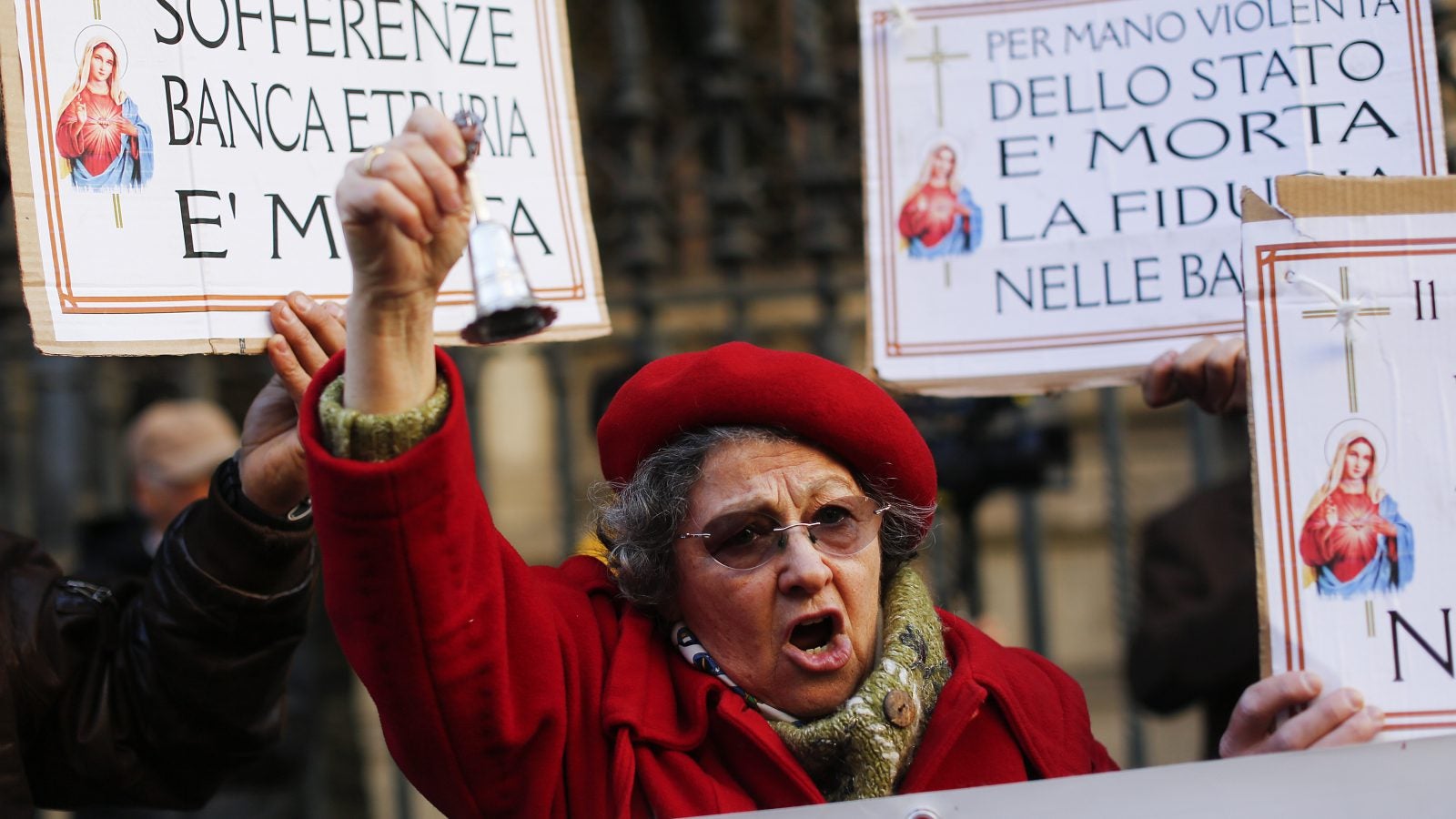In the euro zone’s latest crisis, Italy is torn between saving the banks or saving its people
Italy’s leaders are caught in a bind.


Italy’s leaders are caught in a bind.
The UK’s June vote to leave the European Union set off shockwaves across the bloc, which in turn exposed long-simmering weaknesses in Italy’s banks—possibly leading to the euro zone’s next crisis.
The country’s biggest banks’ share prices, which were already under pressure, plummeted after the Brexit vote. Many are carrying too much bad debt that cannot be recouped. The Italian government, which has been dragging its feet on reforming its sickly financial system (paywall), might now need to step in and forestall an institutional failure that would be disastrous for the economy.
But if Italy bails out the banks, it could to drag tens of thousands of ordinary Italians into the mess, too.
That’s because, in Italy, ordinary savers have historically bought bank bonds pitched to them as safe places to park their cash, akin to the relative safety of government bonds. The origins of this practice go way back in the history of a country where banking is tied closely to local communities (paywall).
So, a bailout would help those investors, right? The answer is no (paywall). As a source close to Matteo Renzi’s government told the Financial Times (paywall), “If we bail in subordinated debt, people will not be able to live.”
Sharing the pain
New EU rules came into effect this year, putting more of the responsibility for rescuing failed banks onto their creditors, instead of taxpayers, in the aftermath of huge bailouts across Europe. (The EU and IMF has bailed out Greece—three times—as well as Ireland, Portugal, Cyprus, and Spain’s banks.)
But things get complicated when those creditors are not a handful of sophisticated institutional investors with diversified portfolios, but thousands of ordinary citizens with their life savings tied up in bank bonds they thought were safe.
Up to half of the most junior (“subordinated”) bonds issued by Italian banks—which take the first hit when a bank is in trouble—are owned by 60,000 retail investors, the FT reported. At Monte dei Paschi di Siena, the world’s oldest bank that has been in perpetual crisis for the past few years, ordinary people own €5 billion ($5.5 billion) of subordinated debt.
The new EU rules state that any state bailout must trigger a “bail in” from creditors, meaning that bondholders forgive a share of debt before taxpayer funds are used to bolster bank balance sheets. That has already started at some small banks. The resultant losses led to protests, as Italians saw their life savings disappear. Two people killed themselves in the wake of losses.
The latest phase of Italy’s banking crisis is linked to the Brexit vote, which has rattled markets across the continent. But the UK voting to leave the EU didn’t expose any particularly new problems over in Italy. Italian banks’ weaknesses were first exposed by the global financial crisis, but unlike in many other affected European countries, Italy’s banks didn’t immediately go through a period of reform.
In total, about €360 billion (paywall)—17% of the banks’ balance sheets—are “non-performing” (that is, unlikely to be repaid in full).
Some are saying the country has now missed the window of opportunity to clean up its banking sector without widespread pain, since the EU’s bail-in rules are now into force. On July 29, the results of Europe’s latest stress tests will reveal more gory details of Italy’s horrifying bank balance sheets. European officials are waiting for those details (paywall) before saying too much about what they are willing to do to help Italy get out of its mess.
Another referendum looms
So, what are Italy’s options? Trying to skirt the EU’s bail-in rules would damage its relationship with the bloc, which is keen to stick to rules it only just passed. The last thing the EU wants is another wayward member rejecting its strictures.
There is one possible loophole. Italy could say that savers were mis-sold the bank bonds as less risky than they turned out to be, and create a fund to compensate savers for the losses imposed by the EU’s bail-in rules. It would be a classic European fudge: By the letter of the law, creditors are bailed-in, but in practice they’re repaid in full.
All told, after write-downs, bail-ins, and the like, Italian banks may need around €40 billion to boost their capital cushions to suitable levels, which is about what it cost to rescue Spanish banks a few years ago. The euro zone was willing to provide up to €100 billion to Spanish banks, so it’s not as if an Italian bailout is unaffordable. It’s just complicated.
At a time when the EU has been severely jolted by one of its biggest members, it is not in the mood to bend its rules for another troublesome country. But at the same time, there is a risk that the anti-EU mood among Italians, which is already strong, could be provoked further if the government is seen as putting supranational rules before ordinary citizens. Fittingly, Italy is holding a referendum in October on constitutional reforms to streamline the country’s governance.
Renzi is likely to step down if the vote goes against him, risking another poll-driven exit that the EU can ill afford.